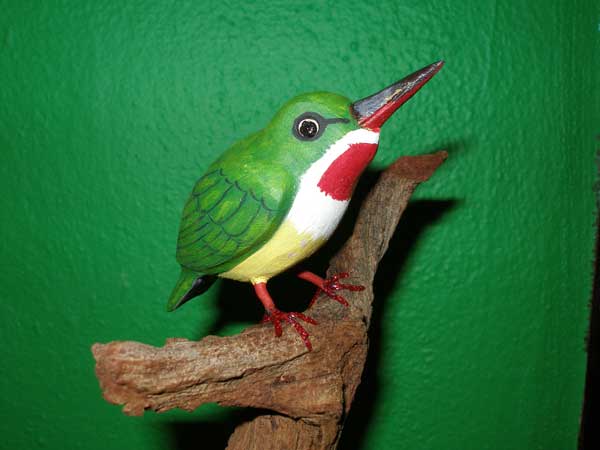San Pedrito
Product #: BPR1
Endemic Bird of Puerto Rico. Made of wood hand carved by local artisan.
Size: Bird 4 1/2 inches (aprox) in length. Base & bird 7 1/2 (aprox) tall
San Pedrito (Puerto Rican Tody) A tiny bright green colored forest bird of Puerto Rico. Habitat: All forest types where there are earthen banks or road cuts for nesting. Most commonly seen in El Yunque and Guanica State Forest.
Description: The Puerto Rican Tody can be described as having green feathers with a yellow flanks, a bright yellow almost white belly, a red throat and lower mandible and a long beak. It is a very small bird and is the smallest representative of the order Coraciiform. This tody measures on average 11cm and weighs from 5 to 6 grams. Males and females can be distinguished by the coloration of their eyes. Males have grey eyes while females have white eyes. Todies are hard to spot visually but are easily identifiable by the loud nasal beep they make.
Habitat: The Puerto Rican Tody can be found throughout the main island of Puerto Rico. It predominates in forested areas, specially in high altitude damp forests where insect concentrations are higher. It also can be found in forests with dense thickets and vines in the south region of the island.
Diet: The Puerto Rican Tody is an insectivourous bird although it has been observed supplementing its hatchilings diet with fruits from the Clusia krugiana tree. It eats insets and small lizards. Todies are considered voracious eaters. Todies sit quietly on high perches and scan the surface below with fast, jerky motions of its bill which it has the habit of tilting towards the sky. Once it find its prey it will suddenly take flight, grab the insect and sit on another perch.
Reproduction: The Puerto Rican Tody has an unusual nesting technique. The male and female todies excavate a long, narrow burrow in an earth bank ranging from 25 to 35 cm in length. They create their nest at the end of this burrow. This process occurs from February to June, before the start of the wet season. Females then lay from 1 to 4 bright white eggs, with an average of 2.3 eggs. Both the male and the female incubate the eggs. The incubation period has an average of 21 days. Other adult todies may assist in the development process of the chicks.
Unique features: The Puerto Rican Tody has been researched extensively because of its unusual body temperature, body temperature control and temperature control abilities. Puerto Rican Todies exhibit lower body temperatures than other todies and have also exhibited heterothermy over a range of temperatures. Most coraciiformes have a body temperature of 40 °C, but Puerto Rican Todies can maintain a body temperature of 36.7 °C. This allows them to spend 33% less energy than others. Puerto Rican Todies can lower their body temperatures by 14 °C and remain fully active.
Source of information: Wikipedia.com
